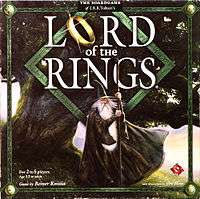Lord of the Rings (board game)
 | |
| Designer(s) | Reiner Knizia |
|---|---|
| Publisher(s) |
Kosmos Hasbro Fantasy Flight Games 999 Games |
| Players | 2–5 |
| Setup time | 5 minutes |
| Playing time | 45–75 minutes |
| Random chance | Medium (Cards, Dice) |
| Skill(s) required | Cooperation |
Lord of the Rings is a board game based on the high fantasy trilogy The Lord of the Rings by J. R. R. Tolkien. Published in 2000 by Kosmos in Germany, Wizards of the Coast in the U.S., and Parker Brothers in the U.K., the game is designed by Reiner Knizia and features artwork by illustrator John Howe. It won a Spiel des Jahres special award for best use of literature in a game and in 2004 it won the Games Magazine Games 100 Honor in the Family Strategy category. A slightly revised version was later published by Fantasy Flight Games.
The board game was highly unusual when it was published, because it is a cooperative board game — each player plays a hobbit in the party, and the party will succeed or fail as a group to destroy the One Ring, thus winning or losing the game.
Game play
Game play is centered on advancement through a series of scenarios corresponding to the adventures of the books. Players turn tiles and play cards in order to move forward, and collect and spend tokens to avoid advancement toward the Dark Lord Sauron. In dire situations, tokens may be spent to call for the assistance of Gandalf, or the One Ring may be used to speed advancement at the cost of moving closer toward Sauron. On the master board there are three locations: Bag End, Rivendell, and Lothlórien. The game starts at Bag End and each player draws a card identifying the player's Hobbit character, each of which has a special ability. Each player is dealt cards that allow him to complete four different activities: traveling, hiding, friendship or fighting. One hobbit is initially assigned to be the "ring bearer", but a new hobbit may become the ring bearer after each scenario is completed. The journey through the game calls for jumping back and forth between the main board and the other four boards. Players advance through locations such as Rivendell, Lothlórien, Moria, Helm's Deep, Shelob’s Lair, and Mordor; all while trying to stay away from the dark lord Sauron. Players are eliminated if they are on the same space as Sauron or are behind him. The game concludes when the fellowship reaches Mount Doom and destroys the Ring, the ring bearer is eliminated, or if the Fellowship reaches Mount Doom yet all players are eliminated before the ring is destroyed. Players need to cooperate and work together in order to beat this game. Players must display strategy and have a little luck. Knowledge of The Lord of the Rings plot isn’t needed to play the game, yet might help in some situations.
Expansion packs
Three expansions currently exist, the Friends & Foes Expansion, Sauron Expansion, in which one player takes the role of Sauron and plays against all others, and Battlefields.
Limited Edition
The game was also released in a "Limited Edition" version, limited to 250 German and 500 English copies. The set features a box signed by game designer Knizia and illustrator Howe, as well as an art print limited to 750 copies, created and signed by Howe. The game board and pieces are identical to the standard version, with the exception of pewter hobbit character pieces and a 22-kt. gold One Ring. List price for this version was approximately $300 US.
Other Tolkien-based games
More than twenty Tolkien-games have been published since 1970, when the board game "Conquest of The Ring" was first released by gaming company Hobbit Toy and Games. A full and updated list of the games can apparently be found on the enthusiast website "Tolkien Boardgames" mentioned below.
Reception
Teeuwynn Woodruff comments: "Where Reiner Knizia's Lord of the Rings board game delivers brilliantly is in conveying this all-important feeling of fellowship through every aspect of its design. In order to beat the game, players must talk to each other, work together, and one or more Hobbits may have to sacrifice themselves so that the Ring-bearer can get to Mount Doom and destroy his dangerous burden. When your group manages to achieve this lofty goal, it's a victory for all. In this, players get to realize, to some degree, the same sense of community that Frodo, Sam, and rest of the Fellowship feels in Middle Earth as they struggle against an overwhelming force, one far more powerful than any of the individuals opposing it. Their incredible strength comes from their unity, and Reiner Knizia's Lord of the Rings board game reflects that truth beautifully."[1]
References
- ↑ Woodruff, Teeuwynn (2007). "Lord of the Rings". In Lowder, James. Hobby Games: The 100 Best. Green Ronin Publishing. pp. 183–187. ISBN 978-1-932442-96-0.
External links
- Lord of the Rings, Friends & Foes expansion and Sauron expansion at BoardGameGeek
- Lord of the Rings Board Game FAQ containing detailed, expanded rules approved by Reiner Knizia
- Main page on FantasyFlightGames.com
- Lord of the Rings Board Game
- Tolkien Boardgames An enthusiast collectors website